From Plebian to Royalty:
Who Wore Stays?
For a long time now I've held a question mark over this subject, never quite sure as to what to think.
As we've been researching for HandBound Costumes, I've begun to collect images that show women in stays from various walks of life. The idea of this blog is to lay them all out, hopefully in some kind of order and have a good look at them. I am hoping to feel a lot clearer about 'Who Wore Stays' once we're done! Forgive the messiness of this post - I will really try and make it logical but as my own head is reeling, it will be interesting to see how it all comes out. And, please, imput would be lovely!
WARNING: This may be a rather long Post.......
The Fully Boned Stays:
Introduction:
Like many others no doubt, I am currently pouring myself over 'The Dress of the People' by John Styles and I am fascinated by some of the research and documents that this man has found. It is a wonderful book and full of down to earth discussions on eighteenth century Spending and Clothing .But in one particular chapter J.Styles goes through the accounts of a poor farming family and, if I'm honest, it's been stirring up an old area of confusion.
These well crafted, Whaleboned Stays - who wore them?
Now, these are just plain, old stays - half boned and possibly in either leather, linen or wool. The details that come with it just say 1700's but I'd suggest - and only from what I've researched - that these are later on in the century - poss around (or after) the 1770's, I'm basing this on the fact that the waist of these stays is a little high and therefore indicating the rising waistline of the latter part of the century and also the fact that they are half-boned; which also was a later technique - (V&A Museum is one of the sources for this tid-bit of information). They are undeniably plain in appearance and brown but still made with a serious amount of skill and craftmanship.
The words I would have used when first seeing them would be words like: Ordinary, Functional, Working Stays, Practical, Well Worn......But is that my initial bias and presumptive association with the fact that they are 'Brown' in appearance? If I'm honest I think it might be.
Which are from the V&A collection and are dated 1770's. These are also half-boned and made from silk damask. Although these are made of 'silk' and more sumptuous in appearance, does this automatically mean they were for the rich only? This pair have been included in this list because unlike many patterned stays (and these have a damask pattern which you might not be able to see from this wee little picture.) I don't think these were designed to be seen as the stomacher part of a dress but were just fundamentally, plain, functional 'stays'. Next, we have:  A pair of Woollen Stays, which are also from the V&A collection and also echo some of the newer techniques of boning that come in latter part of the Eighteenth Century. The V&A date them as 1770-80 and say that they consist of: 'Wool backed with linen or canvas, stitched with linen thread reinforced with strips of whalebone, lined with glazed linen, bound with linen twill tape, fastened with plain weave linen tapes and decorated with silk braid and silk ribbon '
A pair of Woollen Stays, which are also from the V&A collection and also echo some of the newer techniques of boning that come in latter part of the Eighteenth Century. The V&A date them as 1770-80 and say that they consist of: 'Wool backed with linen or canvas, stitched with linen thread reinforced with strips of whalebone, lined with glazed linen, bound with linen twill tape, fastened with plain weave linen tapes and decorated with silk braid and silk ribbon '
 A pair of Woollen Stays, which are also from the V&A collection and also echo some of the newer techniques of boning that come in latter part of the Eighteenth Century. The V&A date them as 1770-80 and say that they consist of: 'Wool backed with linen or canvas, stitched with linen thread reinforced with strips of whalebone, lined with glazed linen, bound with linen twill tape, fastened with plain weave linen tapes and decorated with silk braid and silk ribbon '
A pair of Woollen Stays, which are also from the V&A collection and also echo some of the newer techniques of boning that come in latter part of the Eighteenth Century. The V&A date them as 1770-80 and say that they consist of: 'Wool backed with linen or canvas, stitched with linen thread reinforced with strips of whalebone, lined with glazed linen, bound with linen twill tape, fastened with plain weave linen tapes and decorated with silk braid and silk ribbon '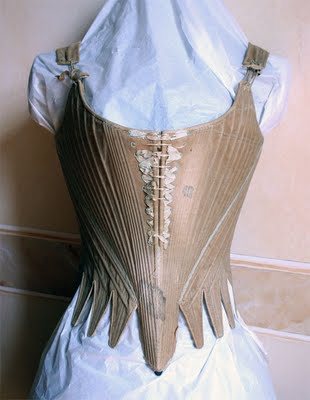 The V&A also give a brief description of stays in general at this point of the 18th cent. They say, and I quote, "Although custom-made and very intricately designed, stays were usually very plain" Which is such an intriguing quote because they're not all plain - so much so that it'd be hard to use the word 'usually'. And the Historians at the V&A aren't silly, so there is obviously a way to view this quote from a different angle that it makes sense. That 'View' might simply be only considering 'One Function Stays'. That is: stays that weren't also designed to be seen as an integral part of the front of the Dress. These 'Two Function Stays' tend to be prettier in fabric, covered (although not always - on many of them the boning channels are visible ) and made to generally be worn with a specific dress (we think!...this is another area that needs research). But back to our main discussion.
The V&A also give a brief description of stays in general at this point of the 18th cent. They say, and I quote, "Although custom-made and very intricately designed, stays were usually very plain" Which is such an intriguing quote because they're not all plain - so much so that it'd be hard to use the word 'usually'. And the Historians at the V&A aren't silly, so there is obviously a way to view this quote from a different angle that it makes sense. That 'View' might simply be only considering 'One Function Stays'. That is: stays that weren't also designed to be seen as an integral part of the front of the Dress. These 'Two Function Stays' tend to be prettier in fabric, covered (although not always - on many of them the boning channels are visible ) and made to generally be worn with a specific dress (we think!...this is another area that needs research). But back to our main discussion. 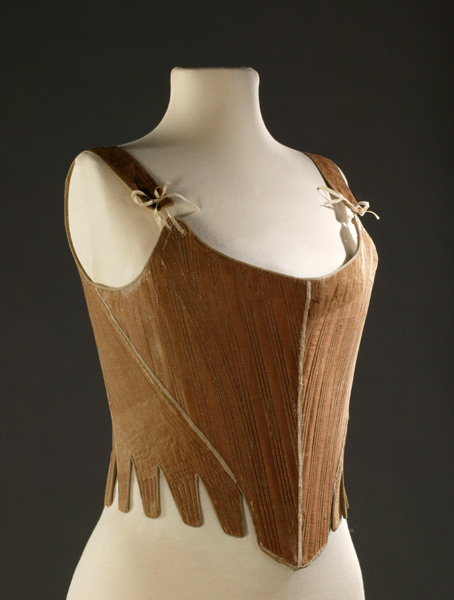 All of these stays here, and those following - bar the V&A silk damask stays - are made of linen or wool and are plainer in appearance and not of the type of Stays that also doubled up as Stomachers (as previously mentioned).I once went to a re-enactment with the sole purpose to talk to some of the ladies about their stays. Many re-enactors are wonderful about accuracy and therefore I was really interested in what research they had turned up in their quest for accuracy. Now, this comment may be completely invalid as the Re-enactment was for 100 years prior to our period, but it's a comment I've heard and read
All of these stays here, and those following - bar the V&A silk damask stays - are made of linen or wool and are plainer in appearance and not of the type of Stays that also doubled up as Stomachers (as previously mentioned).I once went to a re-enactment with the sole purpose to talk to some of the ladies about their stays. Many re-enactors are wonderful about accuracy and therefore I was really interested in what research they had turned up in their quest for accuracy. Now, this comment may be completely invalid as the Re-enactment was for 100 years prior to our period, but it's a comment I've heard and read 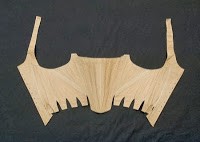 from other sources and one that is the backbone to my questioning. The lovely lady said: 'Boned Bodies (stays) weren't really worn by the working women and the poorer classes because- and lets face it - they're really impractical.' I'll admit that this quote is not verbatim - I don't have that good a memory - but what she said was definitely along these lines and very adamant in the fact that boned bodies would've been impractical for working women to do their working tasks in. Now: from this point on I have no idea how to lay out my argument or my images. So, I think I'm just going to write and hope it makes sense by the end, placing the images in where I can. Within these images we have more examples of plain linen or woollen stays, we have paintings of poorer plebian women wearing stays, we have paintings of plebeian women not wearing stays, helpfully we have paintings that could be either: I couldn't tell so I just thought I'd shove them in for good measure. We have paintings of the upper classes wearing their stays and then we have quotes from accounts where plebeian women have owned or bought specifically 'whalebone' or 'whalebone and silk' stays and we have contemporary references to leather stays and 'cheap stays'.
from other sources and one that is the backbone to my questioning. The lovely lady said: 'Boned Bodies (stays) weren't really worn by the working women and the poorer classes because- and lets face it - they're really impractical.' I'll admit that this quote is not verbatim - I don't have that good a memory - but what she said was definitely along these lines and very adamant in the fact that boned bodies would've been impractical for working women to do their working tasks in. Now: from this point on I have no idea how to lay out my argument or my images. So, I think I'm just going to write and hope it makes sense by the end, placing the images in where I can. Within these images we have more examples of plain linen or woollen stays, we have paintings of poorer plebian women wearing stays, we have paintings of plebeian women not wearing stays, helpfully we have paintings that could be either: I couldn't tell so I just thought I'd shove them in for good measure. We have paintings of the upper classes wearing their stays and then we have quotes from accounts where plebeian women have owned or bought specifically 'whalebone' or 'whalebone and silk' stays and we have contemporary references to leather stays and 'cheap stays'. 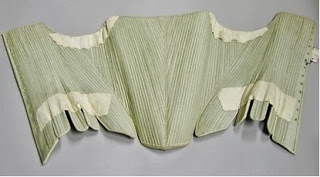 Now, we are not going to include in this debate the Stays made to be seen as Stomachers. Why? Because, although these are beautiful examples of staymaking and design and are still called 'Stays'; the fact that they were made for specific dresses therefore, assumes a larger wardrobe and I'm assuming: a greater amount of choice in clothing options. I'll confess I have questions about these types of stays too but lets keep things simple for now and just deal with the underwear garment that and simply: the Pair of Stays.
Now, we are not going to include in this debate the Stays made to be seen as Stomachers. Why? Because, although these are beautiful examples of staymaking and design and are still called 'Stays'; the fact that they were made for specific dresses therefore, assumes a larger wardrobe and I'm assuming: a greater amount of choice in clothing options. I'll confess I have questions about these types of stays too but lets keep things simple for now and just deal with the underwear garment that and simply: the Pair of Stays.
Essentially what we're comparing here is the two sides of the argument: 'Working class wearing them' or 'Working class NOT wearing them'. Simple really.
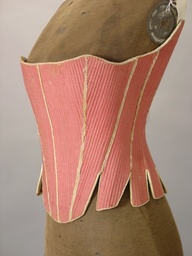
And, I know it sounds daft but I don't quite know what to do with all the Milkmaid images we have. Image wise, there are quite a few portraits/caricatures and romantic paintings of these popular ladies, with them clearly wearing Stays but these images are more likely to be romanticized.  Either the well-to-do woman is dressing down to appear like a milkmaid or the artist is buying into the classic image of 'the milkmaid', so both can be very unreliable. John Styles does point out that in most of the images they are fairly well dressed and this could be likely due to their reliable businesses. Milkmaids, in our minds atleast, do seem to have been in a little class of their own - they earnt their own money, ran their own business and were idealised by wealthy women for way more than for just one fad or for just one generation - all throughout the Eighteenth century in fact, portraits were being painted with their rich patrons dressed up as milkmaids. The Bergere hats were even called the Milkmaid hat and there was a 'country' kind of milkmaid style of clothing. Beau Nash asked the Duchess of Queensbury to remove her Apron in his establishment due to it's lower class connotations. It does seem that this love of the long, gauzy Apron stemmed initially from a flair in fashion to dress up and emulate a 'Milkmaid' and seems to have certainly been the reason why the Duchess was wearing one.
Either the well-to-do woman is dressing down to appear like a milkmaid or the artist is buying into the classic image of 'the milkmaid', so both can be very unreliable. John Styles does point out that in most of the images they are fairly well dressed and this could be likely due to their reliable businesses. Milkmaids, in our minds atleast, do seem to have been in a little class of their own - they earnt their own money, ran their own business and were idealised by wealthy women for way more than for just one fad or for just one generation - all throughout the Eighteenth century in fact, portraits were being painted with their rich patrons dressed up as milkmaids. The Bergere hats were even called the Milkmaid hat and there was a 'country' kind of milkmaid style of clothing. Beau Nash asked the Duchess of Queensbury to remove her Apron in his establishment due to it's lower class connotations. It does seem that this love of the long, gauzy Apron stemmed initially from a flair in fashion to dress up and emulate a 'Milkmaid' and seems to have certainly been the reason why the Duchess was wearing one.
 Either the well-to-do woman is dressing down to appear like a milkmaid or the artist is buying into the classic image of 'the milkmaid', so both can be very unreliable. John Styles does point out that in most of the images they are fairly well dressed and this could be likely due to their reliable businesses. Milkmaids, in our minds atleast, do seem to have been in a little class of their own - they earnt their own money, ran their own business and were idealised by wealthy women for way more than for just one fad or for just one generation - all throughout the Eighteenth century in fact, portraits were being painted with their rich patrons dressed up as milkmaids. The Bergere hats were even called the Milkmaid hat and there was a 'country' kind of milkmaid style of clothing. Beau Nash asked the Duchess of Queensbury to remove her Apron in his establishment due to it's lower class connotations. It does seem that this love of the long, gauzy Apron stemmed initially from a flair in fashion to dress up and emulate a 'Milkmaid' and seems to have certainly been the reason why the Duchess was wearing one.
Either the well-to-do woman is dressing down to appear like a milkmaid or the artist is buying into the classic image of 'the milkmaid', so both can be very unreliable. John Styles does point out that in most of the images they are fairly well dressed and this could be likely due to their reliable businesses. Milkmaids, in our minds atleast, do seem to have been in a little class of their own - they earnt their own money, ran their own business and were idealised by wealthy women for way more than for just one fad or for just one generation - all throughout the Eighteenth century in fact, portraits were being painted with their rich patrons dressed up as milkmaids. The Bergere hats were even called the Milkmaid hat and there was a 'country' kind of milkmaid style of clothing. Beau Nash asked the Duchess of Queensbury to remove her Apron in his establishment due to it's lower class connotations. It does seem that this love of the long, gauzy Apron stemmed initially from a flair in fashion to dress up and emulate a 'Milkmaid' and seems to have certainly been the reason why the Duchess was wearing one.Evidence that plain - especially brown - woollen or linen stays were worn by the wealthier women:
So, first off - if these plain Stays weren't for the working classes then they were for the middle classes and upward, because logically they had to be worn by somebody. Our museums are full of them and they weren't just there to show off their techniques!
- In the National Trust Property of Killerton House there is a pair of leather stays (see above) - fully boned and with traces of a possible previous woollen top layer that has since disappeared. The story behind these Stays was that they'd been passed down from mistress to servant. In which case, if this is true, then this is a clear example of a 'Mistress' having owned a pair of leather or woollen stays, that are plain in appearance. John Styles writes in his explanation of Joseph Highmore's painting 'Pamela  prepares to go home' that she had 'fine clothes given to her by her master and mistress'. I mention this to give another example of clothes being passed down from mistresses to servants, but there is a downfall to this quote. According to the painting and to John Styles' explanation; she was given only 'expensive stays' in the bundle she is returning and they have more of a silken look to them and are white/grey/pale blue rather than being brown. Ok, the difficulty here is there aren't many portraits or images with the wealthy in their under garments and obviously if they are fully clothed we cannot tell what kind of stays they were wearing. The engraving opposite here is titled 'The English Dressing Room' - 1789 and the lady in the centre is in her stays and shift - they are white and decorated. The engraving entitled 'The French Dressing Room' which is of the matching pair (seen to the left now) - also has a lady in her stays and shift, and her stays are silk and blue. But these are just engravings - designed for a purpose and that
prepares to go home' that she had 'fine clothes given to her by her master and mistress'. I mention this to give another example of clothes being passed down from mistresses to servants, but there is a downfall to this quote. According to the painting and to John Styles' explanation; she was given only 'expensive stays' in the bundle she is returning and they have more of a silken look to them and are white/grey/pale blue rather than being brown. Ok, the difficulty here is there aren't many portraits or images with the wealthy in their under garments and obviously if they are fully clothed we cannot tell what kind of stays they were wearing. The engraving opposite here is titled 'The English Dressing Room' - 1789 and the lady in the centre is in her stays and shift - they are white and decorated. The engraving entitled 'The French Dressing Room' which is of the matching pair (seen to the left now) - also has a lady in her stays and shift, and her stays are silk and blue. But these are just engravings - designed for a purpose and that  purpose may well have been the whimsical nature of women dressing - in which case, dressing them in silky stays would far more serve the purpose of the cartoon. Most of the images of wealthy women in their stages of dressing tend to be caricatures and cartoons (see the cartoon on panniers at the very top of the page - dated 1770). All we can do is include them into this debate as examples of images of wealthy women in their stays and those stays being silky. This does not mean they never wore plain
purpose may well have been the whimsical nature of women dressing - in which case, dressing them in silky stays would far more serve the purpose of the cartoon. Most of the images of wealthy women in their stages of dressing tend to be caricatures and cartoons (see the cartoon on panniers at the very top of the page - dated 1770). All we can do is include them into this debate as examples of images of wealthy women in their stays and those stays being silky. This does not mean they never wore plain  brown stays. Merely that there are no images that paint them in such. The following images all have the same problem. Louis Leopold Boilly's painting seems to portray a wealthily dressed lady, in blue silk stockings and with good furniture about her, in light coloured and silk looking stays ( see above). 'The Staymaker's Apprentice' has the lady in yellow stays. Badouin's 'Effects of Reading...' (see below) has a lady with her dress undone and light coloured stays underneath - atleast that is the assumption - they may well be a stomacher. And De Troy's 'Getting ready for a Masque Ball' (see below) has the lady in rich greeny-blue looking stays with centre front lacing. - The ONLY image that helps our case here with plainer stays being worn for the wealthier classes is a little doll. Now dolls could have three purposes in the 18th century. They could be made for children or for young adults as toys and
brown stays. Merely that there are no images that paint them in such. The following images all have the same problem. Louis Leopold Boilly's painting seems to portray a wealthily dressed lady, in blue silk stockings and with good furniture about her, in light coloured and silk looking stays ( see above). 'The Staymaker's Apprentice' has the lady in yellow stays. Badouin's 'Effects of Reading...' (see below) has a lady with her dress undone and light coloured stays underneath - atleast that is the assumption - they may well be a stomacher. And De Troy's 'Getting ready for a Masque Ball' (see below) has the lady in rich greeny-blue looking stays with centre front lacing. - The ONLY image that helps our case here with plainer stays being worn for the wealthier classes is a little doll. Now dolls could have three purposes in the 18th century. They could be made for children or for young adults as toys and  ornaments, or they were samples made up to show, in miniature, the seam-stresses skill and they were also the early version of the fashion plate, being sent from paris to places like London so that the dressmakers for the rich could see what was in fashion and how it was made. The doll here wears a shift, a short hoop and a plain brown pair of Stays. It is seriously unlikely that this doll would have been made with a plebeian audience in mind.
ornaments, or they were samples made up to show, in miniature, the seam-stresses skill and they were also the early version of the fashion plate, being sent from paris to places like London so that the dressmakers for the rich could see what was in fashion and how it was made. The doll here wears a shift, a short hoop and a plain brown pair of Stays. It is seriously unlikely that this doll would have been made with a plebeian audience in mind.
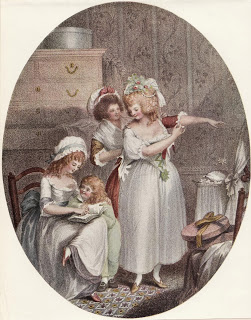 prepares to go home' that she had 'fine clothes given to her by her master and mistress'. I mention this to give another example of clothes being passed down from mistresses to servants, but there is a downfall to this quote. According to the painting and to John Styles' explanation; she was given only 'expensive stays' in the bundle she is returning and they have more of a silken look to them and are white/grey/pale blue rather than being brown. Ok, the difficulty here is there aren't many portraits or images with the wealthy in their under garments and obviously if they are fully clothed we cannot tell what kind of stays they were wearing. The engraving opposite here is titled 'The English Dressing Room' - 1789 and the lady in the centre is in her stays and shift - they are white and decorated. The engraving entitled 'The French Dressing Room' which is of the matching pair (seen to the left now) - also has a lady in her stays and shift, and her stays are silk and blue. But these are just engravings - designed for a purpose and that
prepares to go home' that she had 'fine clothes given to her by her master and mistress'. I mention this to give another example of clothes being passed down from mistresses to servants, but there is a downfall to this quote. According to the painting and to John Styles' explanation; she was given only 'expensive stays' in the bundle she is returning and they have more of a silken look to them and are white/grey/pale blue rather than being brown. Ok, the difficulty here is there aren't many portraits or images with the wealthy in their under garments and obviously if they are fully clothed we cannot tell what kind of stays they were wearing. The engraving opposite here is titled 'The English Dressing Room' - 1789 and the lady in the centre is in her stays and shift - they are white and decorated. The engraving entitled 'The French Dressing Room' which is of the matching pair (seen to the left now) - also has a lady in her stays and shift, and her stays are silk and blue. But these are just engravings - designed for a purpose and that 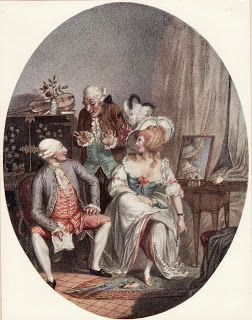 purpose may well have been the whimsical nature of women dressing - in which case, dressing them in silky stays would far more serve the purpose of the cartoon. Most of the images of wealthy women in their stages of dressing tend to be caricatures and cartoons (see the cartoon on panniers at the very top of the page - dated 1770). All we can do is include them into this debate as examples of images of wealthy women in their stays and those stays being silky. This does not mean they never wore plain
purpose may well have been the whimsical nature of women dressing - in which case, dressing them in silky stays would far more serve the purpose of the cartoon. Most of the images of wealthy women in their stages of dressing tend to be caricatures and cartoons (see the cartoon on panniers at the very top of the page - dated 1770). All we can do is include them into this debate as examples of images of wealthy women in their stays and those stays being silky. This does not mean they never wore plain  brown stays. Merely that there are no images that paint them in such. The following images all have the same problem. Louis Leopold Boilly's painting seems to portray a wealthily dressed lady, in blue silk stockings and with good furniture about her, in light coloured and silk looking stays ( see above). 'The Staymaker's Apprentice' has the lady in yellow stays. Badouin's 'Effects of Reading...' (see below) has a lady with her dress undone and light coloured stays underneath - atleast that is the assumption - they may well be a stomacher. And De Troy's 'Getting ready for a Masque Ball' (see below) has the lady in rich greeny-blue looking stays with centre front lacing. - The ONLY image that helps our case here with plainer stays being worn for the wealthier classes is a little doll. Now dolls could have three purposes in the 18th century. They could be made for children or for young adults as toys and
brown stays. Merely that there are no images that paint them in such. The following images all have the same problem. Louis Leopold Boilly's painting seems to portray a wealthily dressed lady, in blue silk stockings and with good furniture about her, in light coloured and silk looking stays ( see above). 'The Staymaker's Apprentice' has the lady in yellow stays. Badouin's 'Effects of Reading...' (see below) has a lady with her dress undone and light coloured stays underneath - atleast that is the assumption - they may well be a stomacher. And De Troy's 'Getting ready for a Masque Ball' (see below) has the lady in rich greeny-blue looking stays with centre front lacing. - The ONLY image that helps our case here with plainer stays being worn for the wealthier classes is a little doll. Now dolls could have three purposes in the 18th century. They could be made for children or for young adults as toys and 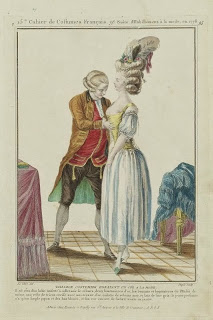 ornaments, or they were samples made up to show, in miniature, the seam-stresses skill and they were also the early version of the fashion plate, being sent from paris to places like London so that the dressmakers for the rich could see what was in fashion and how it was made. The doll here wears a shift, a short hoop and a plain brown pair of Stays. It is seriously unlikely that this doll would have been made with a plebeian audience in mind.
ornaments, or they were samples made up to show, in miniature, the seam-stresses skill and they were also the early version of the fashion plate, being sent from paris to places like London so that the dressmakers for the rich could see what was in fashion and how it was made. The doll here wears a shift, a short hoop and a plain brown pair of Stays. It is seriously unlikely that this doll would have been made with a plebeian audience in mind.
- There are also different types of evidence we can look at. Musuem's across the world dress these plain stays with hoops of various kinds. I realise this sounds a bit off the wall, but a lot of research goes into Musuem's displays and they consistently research, and they consistently dress their mannequins in this way. It is not right to assume they are wrong. It's not hard cold evidence but it is circumstantial evidence - which is still valid to a level. Hoops were much less likely to be worn by the working class - much less likely, in our eyes, than them wearing fully
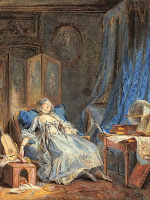 boned stays (and that's not to say they didn't). There are accounts in Mistress's letters of their annoyance at their servants trying to mimic the hooped look by sewing various strips inside their skirts. Surely they were doing this because they didn't have the actual hoops. Much of the silhouette they could achieve was created with quilted petticoats and possibly layers of underskirt and Beavers or Hip-pads. My reasoning is thus; for the museums to dress these plain stays with cane hoops of various sophistication, is a possible nod towards the wealthier women wearing them - ie. that it was accurate that these two items of dress would be worn together. - Another Museum-based bit of logic, is the fact that the reason why the Museums tend to be full of silk satin shoes and heavily embroidered court wear and wealthier women's dresses is that they don't get so much wear as working peoples clothes - and aren't subject to other demanding factors, like money. Wealthier women didn't need to push their garments
boned stays (and that's not to say they didn't). There are accounts in Mistress's letters of their annoyance at their servants trying to mimic the hooped look by sewing various strips inside their skirts. Surely they were doing this because they didn't have the actual hoops. Much of the silhouette they could achieve was created with quilted petticoats and possibly layers of underskirt and Beavers or Hip-pads. My reasoning is thus; for the museums to dress these plain stays with cane hoops of various sophistication, is a possible nod towards the wealthier women wearing them - ie. that it was accurate that these two items of dress would be worn together. - Another Museum-based bit of logic, is the fact that the reason why the Museums tend to be full of silk satin shoes and heavily embroidered court wear and wealthier women's dresses is that they don't get so much wear as working peoples clothes - and aren't subject to other demanding factors, like money. Wealthier women didn't need to push their garments 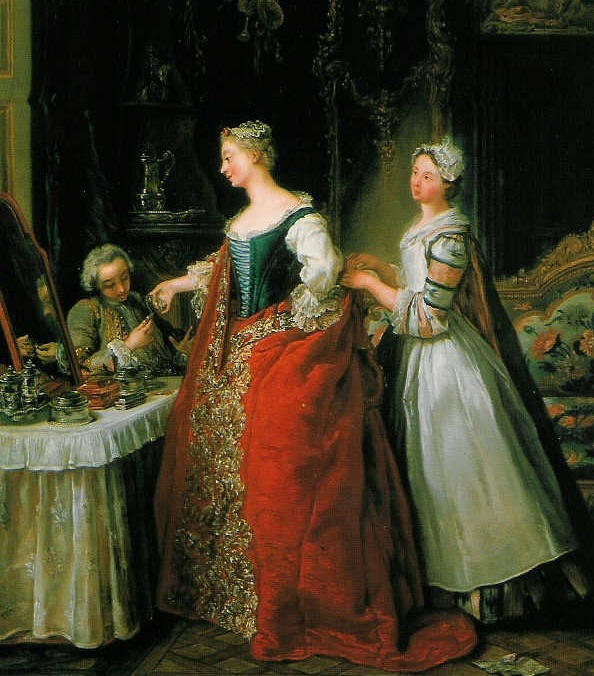 to squeeze every penny out of them. Their dresses weren't always turned into clothing for the children and then into rags, and each individual dress got less airing due to more of a choice in the closet. Also, they had space to store keepsakes, and wealthier generations to follow that would remain keeping the garments without having to cash them in or use the fabric. If most of the other clothing that gains entry into the musuems are from wealthier families why is this not the same for the stays? And why, on the whole, are they in such good condition? - Letter's from the time that we have looked at just tend to just mention 'Stays' - not silk 'Stays' or woollen 'Stays' but just 'Stays'. In Georgiana Cavendish's novel 'The Sylph', for example, she mentions the pinching of stays and the broadness of the curve at the front pushing into her arms, but she doesn't mention the fabric. However, Mrs Delaney does mention in her autobiography that 'The Stays were white silk..." but from all the excerpts we've looked at that's the only one that mentions fabric. - The wonderful Barbara Johnson never mentions fabric for her Stays, in all of her lifetime's collection of keeping a swatch of fabric from the various dresses she had made up for her (see Barbara Johnson's Album of Fashion and Fabrics) not once does she include any for stays. Which is a shame as it would have been most useful! We're not sure if it is because she tended to have stays made that matched the dress or that they were such a functional item that the plain material used for them wasn't considered important enough. And it could of course be neither of these. For now, and I mean this most solemnly, we will have to leave proving that the Middling Sort and Upper Classes wore our particular type of Stays, as I have used up all my evidence. It's got to be pointed out that 100% of the images when showing wealthier ladies in their undergarments - all show them in lighter colours, or blues, or with decorations. None yet have shown plain brown pair of stays apart from the doll.
to squeeze every penny out of them. Their dresses weren't always turned into clothing for the children and then into rags, and each individual dress got less airing due to more of a choice in the closet. Also, they had space to store keepsakes, and wealthier generations to follow that would remain keeping the garments without having to cash them in or use the fabric. If most of the other clothing that gains entry into the musuems are from wealthier families why is this not the same for the stays? And why, on the whole, are they in such good condition? - Letter's from the time that we have looked at just tend to just mention 'Stays' - not silk 'Stays' or woollen 'Stays' but just 'Stays'. In Georgiana Cavendish's novel 'The Sylph', for example, she mentions the pinching of stays and the broadness of the curve at the front pushing into her arms, but she doesn't mention the fabric. However, Mrs Delaney does mention in her autobiography that 'The Stays were white silk..." but from all the excerpts we've looked at that's the only one that mentions fabric. - The wonderful Barbara Johnson never mentions fabric for her Stays, in all of her lifetime's collection of keeping a swatch of fabric from the various dresses she had made up for her (see Barbara Johnson's Album of Fashion and Fabrics) not once does she include any for stays. Which is a shame as it would have been most useful! We're not sure if it is because she tended to have stays made that matched the dress or that they were such a functional item that the plain material used for them wasn't considered important enough. And it could of course be neither of these. For now, and I mean this most solemnly, we will have to leave proving that the Middling Sort and Upper Classes wore our particular type of Stays, as I have used up all my evidence. It's got to be pointed out that 100% of the images when showing wealthier ladies in their undergarments - all show them in lighter colours, or blues, or with decorations. None yet have shown plain brown pair of stays apart from the doll.Evidence of Plebeian women NOT wearing Stays:
Next we shall look at images where Plebeian women are NOT wearing stays and there are quite a few . And some of them, I have admittedly stolen from John Styles book 'Dress of the People'.  First we have 'The female Orators' - see right. The complete print contains 2 ladies, one viewed here on the right and the other on the left. Neither, we think, are wearing stays. Although bedgowns were loose garments, there is still too much baggage in these images for them to wearing stays underneath. Admittedly we can't say this for dead certain but I'd say it's 'pretty certain' that they're not. I've tried to place the images here as large as possible so you can see the shape of the breats (as in this lady here - see right) and the looseness at the back - (see below). The image on the right speaks fairly for itself but the lady below and on the left is a little more donw to interpretation. Here's our logic: We realise that it could be argued that the lady beneath is wearing stays under a loose bed-gown - Brooke mentions that a form of 'Undress' was to wear a relatively loose fitting gown but with the stiff stays still underneath, but we don't think that's the case here. How can we tell? Well, the Stays are such a rigid piece of undergarment that they easily shape the body into a cone. This creates two effects. 1) It means that there is no natural curvature to the bust at the front - which, you can see with the top 'Female Orator' that she definitely has. And 2) the bust is shoved up to the top of the stays and held there. This 'shoving up' of the bust also creates an angle that can be clearly seen beneath any form of clothing bar a loose shawl (which unfortunately a lot of images include).
First we have 'The female Orators' - see right. The complete print contains 2 ladies, one viewed here on the right and the other on the left. Neither, we think, are wearing stays. Although bedgowns were loose garments, there is still too much baggage in these images for them to wearing stays underneath. Admittedly we can't say this for dead certain but I'd say it's 'pretty certain' that they're not. I've tried to place the images here as large as possible so you can see the shape of the breats (as in this lady here - see right) and the looseness at the back - (see below). The image on the right speaks fairly for itself but the lady below and on the left is a little more donw to interpretation. Here's our logic: We realise that it could be argued that the lady beneath is wearing stays under a loose bed-gown - Brooke mentions that a form of 'Undress' was to wear a relatively loose fitting gown but with the stiff stays still underneath, but we don't think that's the case here. How can we tell? Well, the Stays are such a rigid piece of undergarment that they easily shape the body into a cone. This creates two effects. 1) It means that there is no natural curvature to the bust at the front - which, you can see with the top 'Female Orator' that she definitely has. And 2) the bust is shoved up to the top of the stays and held there. This 'shoving up' of the bust also creates an angle that can be clearly seen beneath any form of clothing bar a loose shawl (which unfortunately a lot of images include).  Next is an image by John Masey Wright, titled 'A Rustic Dance', There's no date for this image but as the artist was only born in 1777, I can't imagine it's much before 1810. Still, the main lady, throwing herself into her dancing and looking like she's having a great time
Next is an image by John Masey Wright, titled 'A Rustic Dance', There's no date for this image but as the artist was only born in 1777, I can't imagine it's much before 1810. Still, the main lady, throwing herself into her dancing and looking like she's having a great time  does not look like she cares about Stays either. This is all down to individual interpretation - but she looks far to baggy to be in stays. There is a downside to this though, if the date is anywhere between 1790-1815 then it wasn't in the mode of dress to where the kind of Stays we're concentrating on at any rate. It could also be argued that 'Modes of Fashion' took a while to trickle down to the lower classes and therefore this factor woudn't necessarily count in her case. The next image is called 'The Mutual Embrace (see above). The women being embraced is wearing a bedgown
does not look like she cares about Stays either. This is all down to individual interpretation - but she looks far to baggy to be in stays. There is a downside to this though, if the date is anywhere between 1790-1815 then it wasn't in the mode of dress to where the kind of Stays we're concentrating on at any rate. It could also be argued that 'Modes of Fashion' took a while to trickle down to the lower classes and therefore this factor woudn't necessarily count in her case. The next image is called 'The Mutual Embrace (see above). The women being embraced is wearing a bedgown but is she wearing stays? I don't think she is - the back and side of her torso look a little too relaxed and natural for a figure wearing stays. Please feel free to put your comments in! The lady in the back, sitting on a chair, is also hard to tell and probably completely open to interpretation. She could be wearing stays or she could just be wearing a bodice.
but is she wearing stays? I don't think she is - the back and side of her torso look a little too relaxed and natural for a figure wearing stays. Please feel free to put your comments in! The lady in the back, sitting on a chair, is also hard to tell and probably completely open to interpretation. She could be wearing stays or she could just be wearing a bodice.
 First we have 'The female Orators' - see right. The complete print contains 2 ladies, one viewed here on the right and the other on the left. Neither, we think, are wearing stays. Although bedgowns were loose garments, there is still too much baggage in these images for them to wearing stays underneath. Admittedly we can't say this for dead certain but I'd say it's 'pretty certain' that they're not. I've tried to place the images here as large as possible so you can see the shape of the breats (as in this lady here - see right) and the looseness at the back - (see below). The image on the right speaks fairly for itself but the lady below and on the left is a little more donw to interpretation. Here's our logic: We realise that it could be argued that the lady beneath is wearing stays under a loose bed-gown - Brooke mentions that a form of 'Undress' was to wear a relatively loose fitting gown but with the stiff stays still underneath, but we don't think that's the case here. How can we tell? Well, the Stays are such a rigid piece of undergarment that they easily shape the body into a cone. This creates two effects. 1) It means that there is no natural curvature to the bust at the front - which, you can see with the top 'Female Orator' that she definitely has. And 2) the bust is shoved up to the top of the stays and held there. This 'shoving up' of the bust also creates an angle that can be clearly seen beneath any form of clothing bar a loose shawl (which unfortunately a lot of images include).
First we have 'The female Orators' - see right. The complete print contains 2 ladies, one viewed here on the right and the other on the left. Neither, we think, are wearing stays. Although bedgowns were loose garments, there is still too much baggage in these images for them to wearing stays underneath. Admittedly we can't say this for dead certain but I'd say it's 'pretty certain' that they're not. I've tried to place the images here as large as possible so you can see the shape of the breats (as in this lady here - see right) and the looseness at the back - (see below). The image on the right speaks fairly for itself but the lady below and on the left is a little more donw to interpretation. Here's our logic: We realise that it could be argued that the lady beneath is wearing stays under a loose bed-gown - Brooke mentions that a form of 'Undress' was to wear a relatively loose fitting gown but with the stiff stays still underneath, but we don't think that's the case here. How can we tell? Well, the Stays are such a rigid piece of undergarment that they easily shape the body into a cone. This creates two effects. 1) It means that there is no natural curvature to the bust at the front - which, you can see with the top 'Female Orator' that she definitely has. And 2) the bust is shoved up to the top of the stays and held there. This 'shoving up' of the bust also creates an angle that can be clearly seen beneath any form of clothing bar a loose shawl (which unfortunately a lot of images include).  Next is an image by John Masey Wright, titled 'A Rustic Dance', There's no date for this image but as the artist was only born in 1777, I can't imagine it's much before 1810. Still, the main lady, throwing herself into her dancing and looking like she's having a great time
Next is an image by John Masey Wright, titled 'A Rustic Dance', There's no date for this image but as the artist was only born in 1777, I can't imagine it's much before 1810. Still, the main lady, throwing herself into her dancing and looking like she's having a great time 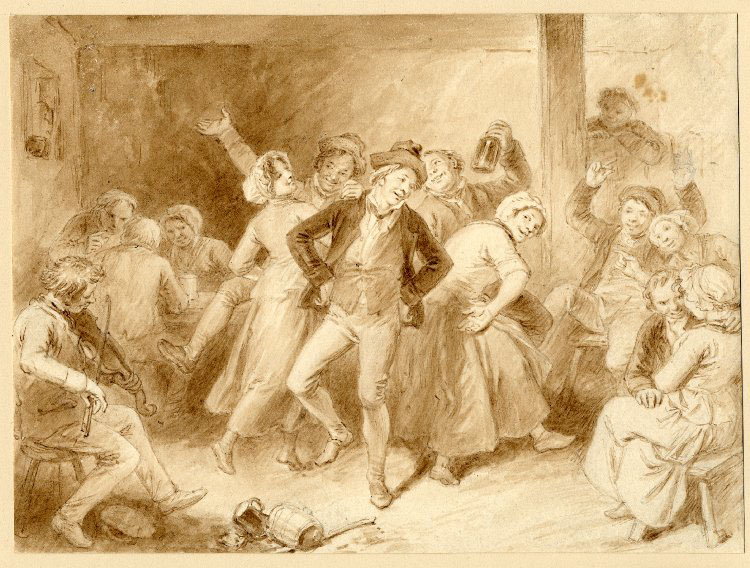 does not look like she cares about Stays either. This is all down to individual interpretation - but she looks far to baggy to be in stays. There is a downside to this though, if the date is anywhere between 1790-1815 then it wasn't in the mode of dress to where the kind of Stays we're concentrating on at any rate. It could also be argued that 'Modes of Fashion' took a while to trickle down to the lower classes and therefore this factor woudn't necessarily count in her case. The next image is called 'The Mutual Embrace (see above). The women being embraced is wearing a bedgown
does not look like she cares about Stays either. This is all down to individual interpretation - but she looks far to baggy to be in stays. There is a downside to this though, if the date is anywhere between 1790-1815 then it wasn't in the mode of dress to where the kind of Stays we're concentrating on at any rate. It could also be argued that 'Modes of Fashion' took a while to trickle down to the lower classes and therefore this factor woudn't necessarily count in her case. The next image is called 'The Mutual Embrace (see above). The women being embraced is wearing a bedgown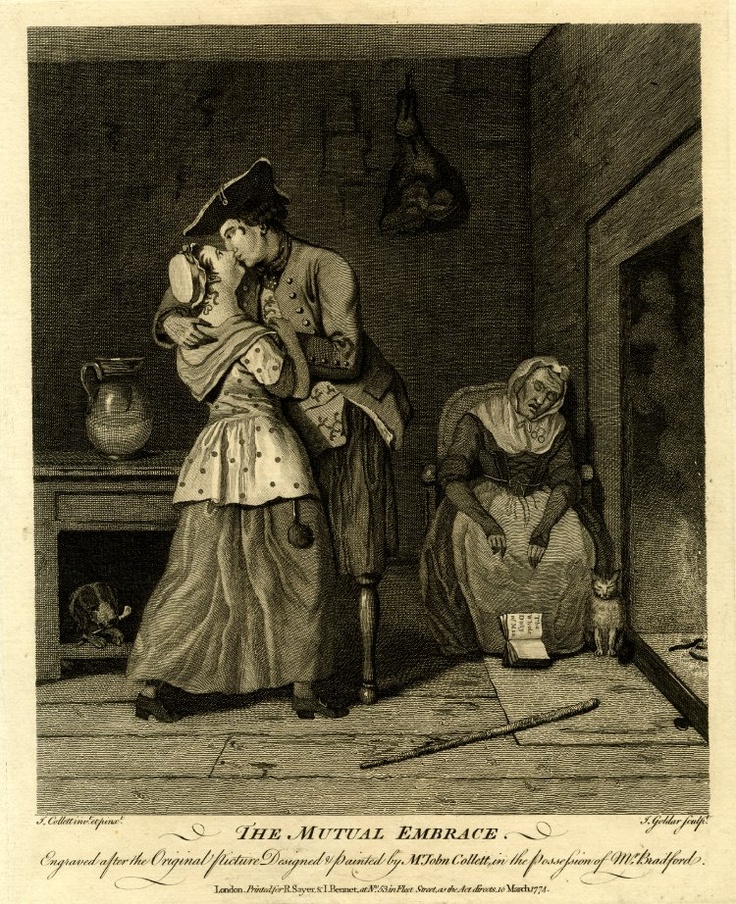 but is she wearing stays? I don't think she is - the back and side of her torso look a little too relaxed and natural for a figure wearing stays. Please feel free to put your comments in! The lady in the back, sitting on a chair, is also hard to tell and probably completely open to interpretation. She could be wearing stays or she could just be wearing a bodice.
but is she wearing stays? I don't think she is - the back and side of her torso look a little too relaxed and natural for a figure wearing stays. Please feel free to put your comments in! The lady in the back, sitting on a chair, is also hard to tell and probably completely open to interpretation. She could be wearing stays or she could just be wearing a bodice.
Next is an amazing image by Paul Sandby - we so appreciate this guy here at HandBound, I can imagine him only drawing what he actually sees! Anyway, it's one of the 'Cries of London' and we don't think she is wearing any stays - her bust looks a little too natural. She is also very poorly dressed - which doesn't help our case, because when we use the word 'plebeian' it comes with the obvious understanding that the state of even one person's life can peak and  trough with times when they are slightly more affluent and times when they are not. Being plebeian does not assume you are always at rock bottom, nor ever at rock bottom - merely that you 'belong to a low social class' (see cambridge dictionary). The fact that she is in tatters and badly dressed means she cannot afford even a basic standard of clothing and therefore far less able to afford a pair of stays. This does not mean she never had an oppurtunity to own a pair or that she wouldn't in the years to come, but that at, right this moment in her life, she is not able to afford even the basic clothing that workhouses would supply (see Dress of the People - J.Styles). Also it is worth stating that this does not mean either, that those who can afford more are classed as 'wealthy' or even of the 'middling sort'.
trough with times when they are slightly more affluent and times when they are not. Being plebeian does not assume you are always at rock bottom, nor ever at rock bottom - merely that you 'belong to a low social class' (see cambridge dictionary). The fact that she is in tatters and badly dressed means she cannot afford even a basic standard of clothing and therefore far less able to afford a pair of stays. This does not mean she never had an oppurtunity to own a pair or that she wouldn't in the years to come, but that at, right this moment in her life, she is not able to afford even the basic clothing that workhouses would supply (see Dress of the People - J.Styles). Also it is worth stating that this does not mean either, that those who can afford more are classed as 'wealthy' or even of the 'middling sort'.
 trough with times when they are slightly more affluent and times when they are not. Being plebeian does not assume you are always at rock bottom, nor ever at rock bottom - merely that you 'belong to a low social class' (see cambridge dictionary). The fact that she is in tatters and badly dressed means she cannot afford even a basic standard of clothing and therefore far less able to afford a pair of stays. This does not mean she never had an oppurtunity to own a pair or that she wouldn't in the years to come, but that at, right this moment in her life, she is not able to afford even the basic clothing that workhouses would supply (see Dress of the People - J.Styles). Also it is worth stating that this does not mean either, that those who can afford more are classed as 'wealthy' or even of the 'middling sort'.
trough with times when they are slightly more affluent and times when they are not. Being plebeian does not assume you are always at rock bottom, nor ever at rock bottom - merely that you 'belong to a low social class' (see cambridge dictionary). The fact that she is in tatters and badly dressed means she cannot afford even a basic standard of clothing and therefore far less able to afford a pair of stays. This does not mean she never had an oppurtunity to own a pair or that she wouldn't in the years to come, but that at, right this moment in her life, she is not able to afford even the basic clothing that workhouses would supply (see Dress of the People - J.Styles). Also it is worth stating that this does not mean either, that those who can afford more are classed as 'wealthy' or even of the 'middling sort'.
The next image is from the Parisian version of the Cries of London (should be just to the right here) and shows a woman 'Higgler' - again I've no date - sorry. But she is clearly wearing no Stays. Another image is a brilliant cartoon of the 'Abusive Fruit Woman' (see way down below) and again, the market stall
here) and shows a woman 'Higgler' - again I've no date - sorry. But she is clearly wearing no Stays. Another image is a brilliant cartoon of the 'Abusive Fruit Woman' (see way down below) and again, the market stall  lady does not have stays on - you can see the shape of her slightly saggy boobs wonderfully. What is interesting about this image is that although she is wearing no stays she is wearing a nice looking hat - possibly of black silk and with a bow. If , and it's a big if as there is absolutely no way from an engraved cartoon to be able to tell if a hat is silk or not, but, IF, she is wearing a silk hat then she is a woman who does care about her clothing, is a woman who has a finery item and who is still not wearing stays.
lady does not have stays on - you can see the shape of her slightly saggy boobs wonderfully. What is interesting about this image is that although she is wearing no stays she is wearing a nice looking hat - possibly of black silk and with a bow. If , and it's a big if as there is absolutely no way from an engraved cartoon to be able to tell if a hat is silk or not, but, IF, she is wearing a silk hat then she is a woman who does care about her clothing, is a woman who has a finery item and who is still not wearing stays.
 here) and shows a woman 'Higgler' - again I've no date - sorry. But she is clearly wearing no Stays. Another image is a brilliant cartoon of the 'Abusive Fruit Woman' (see way down below) and again, the market stall
here) and shows a woman 'Higgler' - again I've no date - sorry. But she is clearly wearing no Stays. Another image is a brilliant cartoon of the 'Abusive Fruit Woman' (see way down below) and again, the market stall 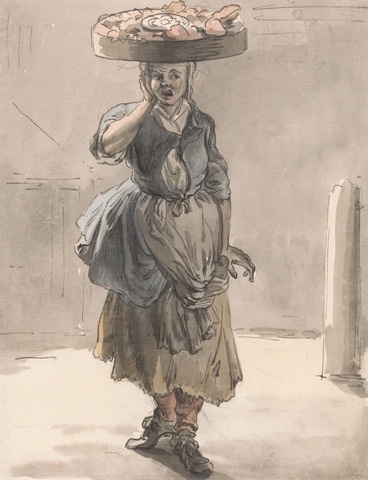 lady does not have stays on - you can see the shape of her slightly saggy boobs wonderfully. What is interesting about this image is that although she is wearing no stays she is wearing a nice looking hat - possibly of black silk and with a bow. If , and it's a big if as there is absolutely no way from an engraved cartoon to be able to tell if a hat is silk or not, but, IF, she is wearing a silk hat then she is a woman who does care about her clothing, is a woman who has a finery item and who is still not wearing stays.
lady does not have stays on - you can see the shape of her slightly saggy boobs wonderfully. What is interesting about this image is that although she is wearing no stays she is wearing a nice looking hat - possibly of black silk and with a bow. If , and it's a big if as there is absolutely no way from an engraved cartoon to be able to tell if a hat is silk or not, but, IF, she is wearing a silk hat then she is a woman who does care about her clothing, is a woman who has a finery item and who is still not wearing stays.
All of these lovely ladies are wearing bedgowns in the above images, of (which is also an interesting point) varying lengths. They also wear a standard skirt beneath. Three have aprons, the others appear to not, and the only one I'm a bit vague on is the lady in Paul Sandby's Cries of London 1759 (two images above) she is either in her shift/smock and tucking her skirt into her arm (poorer woman seem to have been quite in the habit of doing that) or her apron and the white garment showing beneath is a white skirt. As it's a sketch it's hard to tell. Also three of them have some sort of string crossing their chests and in two of these  pictures ('Abusive Fruit Woman' and the first image from 'Female Orators') it seems clear that this string is to hold their shoulder cloak on.
pictures ('Abusive Fruit Woman' and the first image from 'Female Orators') it seems clear that this string is to hold their shoulder cloak on.
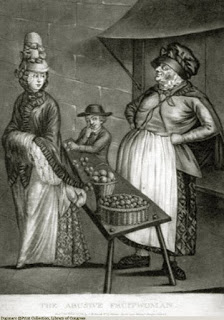 pictures ('Abusive Fruit Woman' and the first image from 'Female Orators') it seems clear that this string is to hold their shoulder cloak on.
pictures ('Abusive Fruit Woman' and the first image from 'Female Orators') it seems clear that this string is to hold their shoulder cloak on.
Next is the image here also by Paul Sandby and entitled 'Light for the cats and Liver for the dogs' (that would've been her cry - wonderful isn't it!) and is dated the same year: 1759 (see above). She also is not wearing stays. And she also is wearing a blue bedgown, her apron is in a knot and is long and she wears a tattered skirt that comes a good 9" above her ankles and displays her wearing either very loose and badly knitted socks or some sort of spats or leg wrappings. Also, it's something I've noticed in other images of plebian women is that shoe laces - proper shoes laces I mean, not literally 'lace' on shoes as the upper classes would call it but 'Lace' in the modern sense of the term - features quite a lot. This lady is also wearing quite a high-necked shift/smock.
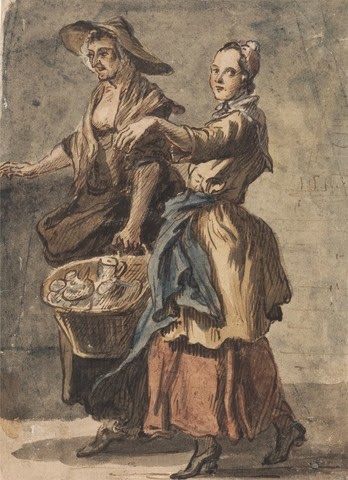 Next we have another Paul Sandby image and it is entitled: 'Two Women holding baskets'. Neither of these two ladies appear to have stays on and the lady in front is wearing a bedgown, her blue apron caught up in the string, a red coloured under skirt with nice-ish looking shoes and a some sort of cap or bonnet tied on with dark
Next we have another Paul Sandby image and it is entitled: 'Two Women holding baskets'. Neither of these two ladies appear to have stays on and the lady in front is wearing a bedgown, her blue apron caught up in the string, a red coloured under skirt with nice-ish looking shoes and a some sort of cap or bonnet tied on with darkkissing strings. She also wears a white scarf about her neck. The lady beyond her, who is a bit more out of sight, is mostly in brown, with a large and full brown apron tucked up, a cap under her wicker hat, full length skirt and a
 vague something-or-other on her top half. She also wears a long shawl. For some reason, she also seems to be almost displaying her breast! This is interesting because the lowness of necklines tended to be a design feature of the more fashionable dress and therefore the stays echoed this shape and as
vague something-or-other on her top half. She also wears a long shawl. For some reason, she also seems to be almost displaying her breast! This is interesting because the lowness of necklines tended to be a design feature of the more fashionable dress and therefore the stays echoed this shape and asdid the shifts. She doesn't look like she's wearing stays but she could be just wearing a brown coarse linen shift with a low neckline and hence why it is flopping down and revealing her chest.
Next we have The Primrose Seller by Francis Wheatley. Painted in 1759 this selection of images contain a lot of interesting Costume features. The lady here does not seem to be wearing a pair of stays - the front of her dress and little too-slouched we think for one supported by stays. To see a larger version of this painting please see our Customer Library on our website and then go to the Francis Wheatley Page.
Evidence of Plebeian Women Wearing Stays:
Evidence of Plebeian Women Wearing Stays:
This has been the most fascinating of all categories - I did squeak a few times when finding some of these images.Now obviously there are some ground rules to explain. In the 1790's Sir frederick Eden produced a report entitled 'The
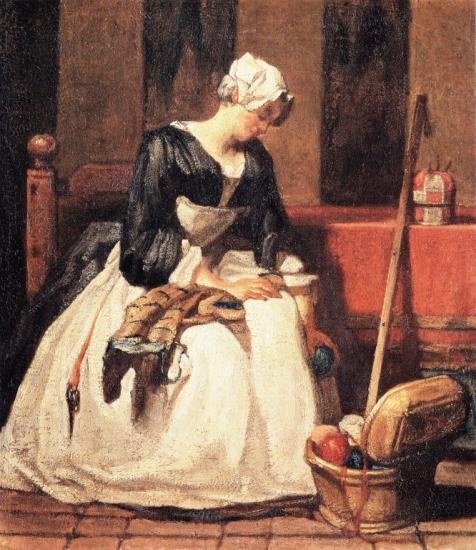 State of the Poor', within this report (and featuring on page 222 of 'The Dress of the People' by John Styles) Eden makes a comment that a cheap pair of stays should last 6 years. We have no definition as to what he meant by a 'cheap pair of stays'. On page 220 of the same book John Styles states that 'cloaks and leather stays...were standard features of working women's wardrobes'. As we have already seen in this post that leather stays could be fully boned (see the Killerton Stays above) but as far as I am
State of the Poor', within this report (and featuring on page 222 of 'The Dress of the People' by John Styles) Eden makes a comment that a cheap pair of stays should last 6 years. We have no definition as to what he meant by a 'cheap pair of stays'. On page 220 of the same book John Styles states that 'cloaks and leather stays...were standard features of working women's wardrobes'. As we have already seen in this post that leather stays could be fully boned (see the Killerton Stays above) but as far as I am 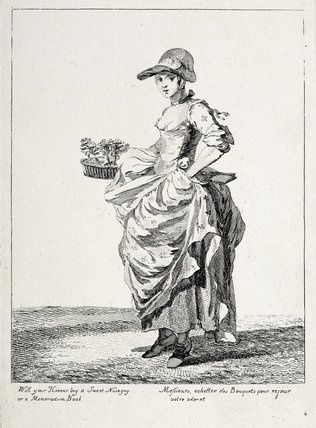 aware, leather stays could also be un-boned, relying on the qualities of leather for the support. I have no evidence for this except it is a common conception. This is important because some of the images here, although to my eye look exactly like a pair of fully boned, brown stays, might infact be 1) leather stays cut to the same shape or 2) a 'cheap pair of stays' that could be made using cheaper materials or cheaper techniques - we don't know.
aware, leather stays could also be un-boned, relying on the qualities of leather for the support. I have no evidence for this except it is a common conception. This is important because some of the images here, although to my eye look exactly like a pair of fully boned, brown stays, might infact be 1) leather stays cut to the same shape or 2) a 'cheap pair of stays' that could be made using cheaper materials or cheaper techniques - we don't know.With such indefinition what's the point in going on? Well, in chapter 14 of 'The Dress of the People' John Styles concentrates on the family accounts of a poor and low wage farming family whose wages matched the 'labouring poor' that Eden set his report on. This means that we know that not only are they classed as 'plebeian' but that they are at the lower waged end of the 'plebeian' class. Now these family accounts (The family is called the 'Latham's') range from 1724 right through to 1754
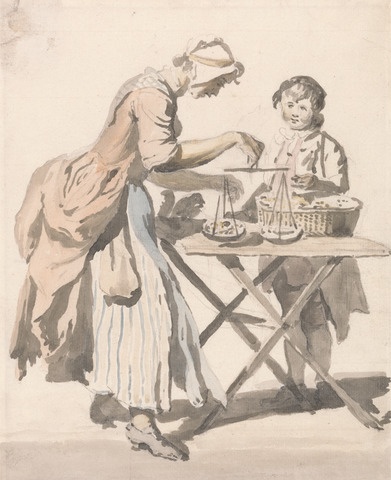 and covers both the periods of the Lathan's having children (their poorest stage), to where some of the children had grown up and were therefore able to bring a wage in to the home and where the mother was now more freed up to work (this is their wealthiest stage). Even in their wealthiest stage their income is still considerably low. All four of the older daughters (whose years are covered in this period) have 'between one and three pairs of expensive whalebone stays' (John Styles p.236). The mother too acquired a pair of 'whalebone stays'. John Styles also thinks it likely that these stays could have been passed down to the younger daughters.
and covers both the periods of the Lathan's having children (their poorest stage), to where some of the children had grown up and were therefore able to bring a wage in to the home and where the mother was now more freed up to work (this is their wealthiest stage). Even in their wealthiest stage their income is still considerably low. All four of the older daughters (whose years are covered in this period) have 'between one and three pairs of expensive whalebone stays' (John Styles p.236). The mother too acquired a pair of 'whalebone stays'. John Styles also thinks it likely that these stays could have been passed down to the younger daughters.In another case, six of a manufacturer's servants (a one Mr Heaton) bought 'new' whalebone stays which John Styles explains as: 'Stays, though fundamental to the eighteenth century wardrobe and fashionable silhouette, were extremely expensive when made from whalebone and acquired new. Those described as 'new' in Heaton's accounts cost between 16 shillings and 24 shillings'. From Workhouse accounts there is evidence of women having arrived destitute but with 'Stays' in their possession and there are cases of Workhouses clothing their inmates with 'Stays'. Alice Godfrey is a shining example of this, in Cheshire she was supplied with a pair of stays by the workhouse there.
Stays didn't seem to have to be 'made to measure' or 'brand new' - in the Latham family's accounts they also register buying from a Tailors atleast one pair of second hand stays. And eight of Heaton's (the manufacturer again) servants bought second hand stays. The point is, that whether the Stays were bought brand new or second hand, these are clear examples of plebeian women purchasing and wearing whalebone stays.
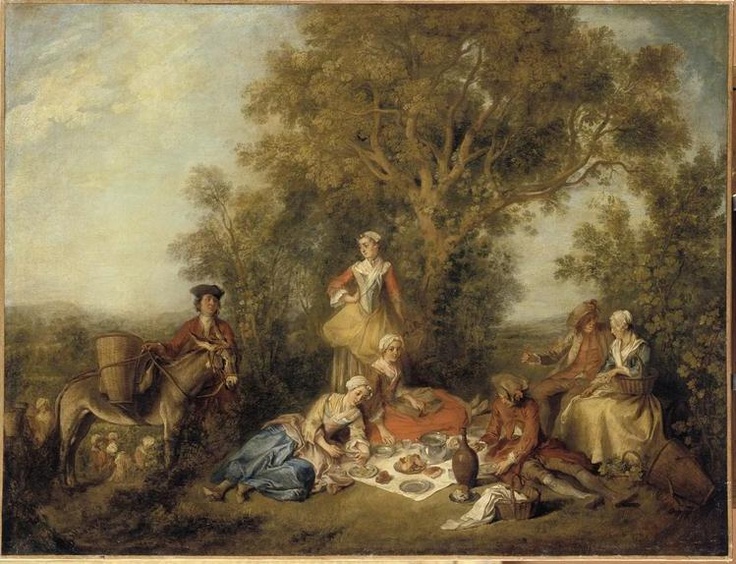 The images for this section all include what we consider pretty clear examples of boned stays - although we do concede that, especially with the lack of the definition of 'Cheap stays' (Eden in the 1790's) it's hard to be conclusive.
The images for this section all include what we consider pretty clear examples of boned stays - although we do concede that, especially with the lack of the definition of 'Cheap stays' (Eden in the 1790's) it's hard to be conclusive.- The first image is entitled 'the Embroideress' and is by Chardin (no exact date). From her clothes and the
 surrounding furniture we can glean that she is not the poorest of working women but she is still a good example of a working woman wearing a pair of stays. She has such a swelling above her bust line, such a forced in cone-like shape that it seems pretty obvious that she is wearing a pair of boned stays. She also sports a really long and full working apron and is wearing what looks likes a Robe a l'Anglais.
surrounding furniture we can glean that she is not the poorest of working women but she is still a good example of a working woman wearing a pair of stays. She has such a swelling above her bust line, such a forced in cone-like shape that it seems pretty obvious that she is wearing a pair of boned stays. She also sports a really long and full working apron and is wearing what looks likes a Robe a l'Anglais.- The next image is another Paul Sandby sketch (see a little bit above) and although it is a basic drawing there are several things that suggest that she is wearing a pair of stays. She has a controlled look about her torso, she has the low decolletage and low shift neckline as well, which suggest a pair of stays, as they tended to be cut very low. She has the pushed up bust and there is no centre front opening to her top which would suggest a pair of bodies. She, like some of the other plebeian images above is wearing her apron tucked into the band and a basic skirt. She looks fairly well 'bustled' as well, her skirts looking like she is either wearing a few layers to create the effect or actual hip-pads or a quilted petticoat which we're unable to see.
- The next image to that, is the one on the right and is entitled 'Black Heart Cherries', also by Paul Sandby, and featuring in the 'Cries of London' series, 1759. This is quite an intriguing sketch. For starters, her torso when looked at as a whole (even though her arm cuts across it) is a definite cone shape and very rigid in form. Her bust is also up and she isn't 'waisted' in the sense of having that natural curvature to the waist one would expect on a non-stayed shape. Just for interest she also has a striped skirt and, what's most exciting to us, is having an actual drawing that shows a lady wearing her pockets. Even though it's in watercolour and therefore quite vague, you can still see her large-ish pockets (plain and much bigger than the embroidered ones you find in the museums) appearing from under her pulled up skirts. These pulled up skirts are another satisfying fact. I love the way Paul Sandby has even managed to get that accurate look of a thin dress and the way that linen looks when it's dragged up. Brooke mentions in her book that skirts were starting to be tucked up right from the late 40's and it's lovely to see an example of what this looked like. It's so easy to get this look confused with the Polonaise style that hit England a few years later.
 - The large image is a painting by Lancret that was one in a collection of Four and based on the 'Season's'. It was painted in 1738. This is Autumn pictured here and atleast three of the ladies seem to have silhouettes that would suggest stays. Although there's no definite hint to the wealth of the sitters (the other important factor to making this image useful), there are certain keys we can use to guess their slightly lower statuses. First, all of their clothing are simple basic colours and lack any of the fresher colours and patterns that were coming in. The centre front lady is the only one who appears to have a fashionable colour with her blue satin-looking skirt but it is an interesting mix. She wears an apron that has a bib front which suggests a working apron (Cunnington's '64) and no dress, which would be more expected if she was of a wealthier class. The yellow-ish/beige-ish sleeves seem to suggest a bedgown as no skirt can be seen ruffled about the ground around her. The other women all join her in a skirt and bedgown/coat except the lady standing up who seems to be in a pair of stays. If you look closely at her, the bodice part of her dress has such a controlled and pointed and shaped look about it - exactly like a pair of mid-century stays; broad and very high. Now, according to this painting, she is also wearing a pair of sleeves with these Stays. Sleeves were worn with stays but is a fashion that came in from the previous century. It's funny how some images create more questions than they answer! She also seems to wear her apron tucked up in the same way the other plebeian women in the above section had worn theirs. The only man whose stockings we can see, sports a dark pair which speaks highly of plebeian status. Him and all the other men are dressed in very plain breeches and coats, in various shades of brown. They also have a donkey in their midst which I would have thought was quite an un-posh thing to do, and although they are having a picnic which in our minds seems like quite genteel thing to do, it was a past-time that social writers of the day either commended or criticised the workers for doing. Wow this is wordy!
- The large image is a painting by Lancret that was one in a collection of Four and based on the 'Season's'. It was painted in 1738. This is Autumn pictured here and atleast three of the ladies seem to have silhouettes that would suggest stays. Although there's no definite hint to the wealth of the sitters (the other important factor to making this image useful), there are certain keys we can use to guess their slightly lower statuses. First, all of their clothing are simple basic colours and lack any of the fresher colours and patterns that were coming in. The centre front lady is the only one who appears to have a fashionable colour with her blue satin-looking skirt but it is an interesting mix. She wears an apron that has a bib front which suggests a working apron (Cunnington's '64) and no dress, which would be more expected if she was of a wealthier class. The yellow-ish/beige-ish sleeves seem to suggest a bedgown as no skirt can be seen ruffled about the ground around her. The other women all join her in a skirt and bedgown/coat except the lady standing up who seems to be in a pair of stays. If you look closely at her, the bodice part of her dress has such a controlled and pointed and shaped look about it - exactly like a pair of mid-century stays; broad and very high. Now, according to this painting, she is also wearing a pair of sleeves with these Stays. Sleeves were worn with stays but is a fashion that came in from the previous century. It's funny how some images create more questions than they answer! She also seems to wear her apron tucked up in the same way the other plebeian women in the above section had worn theirs. The only man whose stockings we can see, sports a dark pair which speaks highly of plebeian status. Him and all the other men are dressed in very plain breeches and coats, in various shades of brown. They also have a donkey in their midst which I would have thought was quite an un-posh thing to do, and although they are having a picnic which in our minds seems like quite genteel thing to do, it was a past-time that social writers of the day either commended or criticised the workers for doing. Wow this is wordy!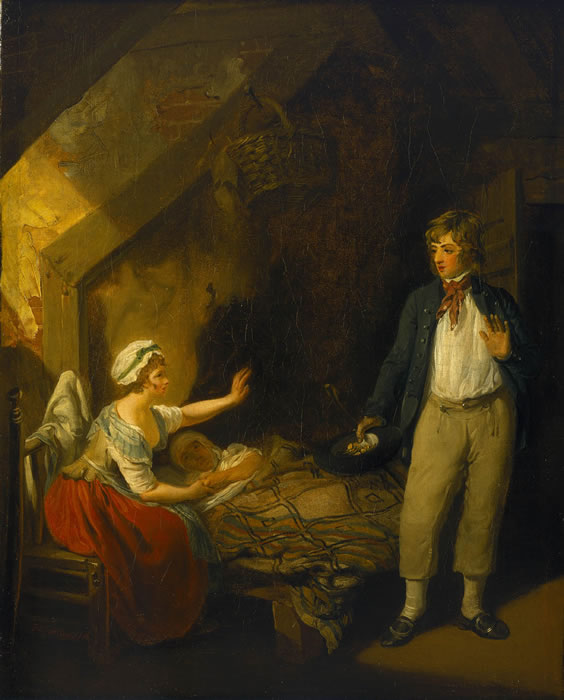 - The next image feels like a discovery of treasure! I still look at this image and grin. It is such a detailed and useful image to work from. It is by McArdell 1756 and it is of a maid sleeping at her work. Not only is she clearly wearing a boned, plain pair of stays but this image also shows us how it could be worn visible and how dresses looked with such a pair of stays at the front. It really is a wonderful image. the detail of her shift sleeves is useful aswell, along with the shifts wavy neckline (we call this the Milkmaid neckline thanks to Francis Hayman's painting of the Milkmaids Dancing). But even the clearness of how her Apron has been tied is comforting and the baggy cut of her sleeves illuminating. We also think that the dress robings (folded fronts) have been tacked onto the stays. If you look at it now it does seem to have that 'pulled look' in that area.
- The next image feels like a discovery of treasure! I still look at this image and grin. It is such a detailed and useful image to work from. It is by McArdell 1756 and it is of a maid sleeping at her work. Not only is she clearly wearing a boned, plain pair of stays but this image also shows us how it could be worn visible and how dresses looked with such a pair of stays at the front. It really is a wonderful image. the detail of her shift sleeves is useful aswell, along with the shifts wavy neckline (we call this the Milkmaid neckline thanks to Francis Hayman's painting of the Milkmaids Dancing). But even the clearness of how her Apron has been tied is comforting and the baggy cut of her sleeves illuminating. We also think that the dress robings (folded fronts) have been tacked onto the stays. If you look at it now it does seem to have that 'pulled look' in that area.- In 1740, Pietro Longhi painted the 'Laundress' and we thank him for it! (Please see above) Just look at the detail! There is no way on this planet that this girl isn't wearing a pair of fully boned, brown stays. The way that it sticks up above her bustline can only be by boning of some kind - I'm not even sure that fabric stiffened with paste would stick up as resolutely as this, especially after doing the laundry with all that steam and moisture. And here, also, is a clear example of her working in her stays. It's also interesting to see a painted example of an un-strapped pair of stays. There is a lot more in this image than just our pair of stays (the massive bagginess of their shifts is a useful piece of evidence, for example) but for now we'll leave this image with just our own special piece of evidence.
- The Sailor's Return is an image that Style's uses in his book 'The Dress if the People'. He uses it to show the dress of the typical sailor but we are going to use it for it's fantastic example of a lady wearing stays. The house that they are in is showing signs of poverty, and the life and earnings of a simple sailor could never be described as wealthy and yet here she sits, in a pair of boned stays, looking after an ailing Father in the bed.
- Next is an image we are most pleased with - it is a painting by George Morland from 1792 and it shows a family of Higglers (this seems to be an old name for Gypsys) preparing for market. The women who is pouring something, seems to definitely be in a pair of boned Stays. See the way the tabs arch and the stiffness to the whole garment and the way the CF point sits - all indicators to it being a pair of boned stays. We will not be dim - it could be stiffened fabric or leather stays moulded but they look like they hold her so well in that we think they are stays.
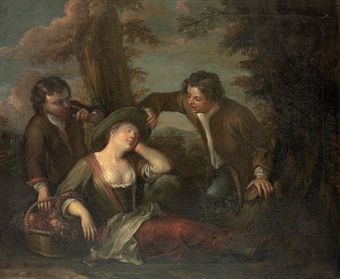 - Next is another painting by George Morland and this time from 1791. It is called Cowherd and Milkmaid and again, this buxom lass seems to be encased in a pair of boned stays. the rigidity of the tabs, the control this garment seems to have, all point to a pair of strong boned stays. She also seems, rather bizarrely, to be wearing silver buckles on her clod-like shoes! Again Morland's detail is astounding and well worth a larger image.
- Next is another painting by George Morland and this time from 1791. It is called Cowherd and Milkmaid and again, this buxom lass seems to be encased in a pair of boned stays. the rigidity of the tabs, the control this garment seems to have, all point to a pair of strong boned stays. She also seems, rather bizarrely, to be wearing silver buckles on her clod-like shoes! Again Morland's detail is astounding and well worth a larger image.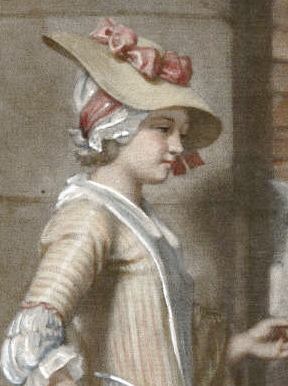 - This next image was sold at Christies, the Auctioneers, and has been attributed to Phillip Mercier. We don't know a date for the actual painting but we do know that he mainly painted between the years of 1710-1760 so we're talking early to mid eighteenth century here. And this is a highly romanticized painting, yet lets not totally dismiss it. It is an example of the lady seemingly wearing a) a very low cut shift with not much ruffle, b) an apparent stomacher in the self fabric as the dress and c) with a shape that looks to be created by a pair of boned stays - just check out the way the breasts have been forced upwards and the flattened front just beneath them. We also have no indication to her status except she is wearing a dull-ish colours, a slim-on-the-fabric Robe a l'Anglais, no adornments and, without wishing to point out the brutally obvious, she's asleep on the ground - not something your average well-to-do lady was up for doing.
- This next image was sold at Christies, the Auctioneers, and has been attributed to Phillip Mercier. We don't know a date for the actual painting but we do know that he mainly painted between the years of 1710-1760 so we're talking early to mid eighteenth century here. And this is a highly romanticized painting, yet lets not totally dismiss it. It is an example of the lady seemingly wearing a) a very low cut shift with not much ruffle, b) an apparent stomacher in the self fabric as the dress and c) with a shape that looks to be created by a pair of boned stays - just check out the way the breasts have been forced upwards and the flattened front just beneath them. We also have no indication to her status except she is wearing a dull-ish colours, a slim-on-the-fabric Robe a l'Anglais, no adornments and, without wishing to point out the brutally obvious, she's asleep on the ground - not something your average well-to-do lady was up for doing. - Next is a close-up detail from the painting 'The Pretty Maid' from 1779 and part of the Bowles Collection. It's a fantastic images as it shows how clothes looked on the practical side of things. I bet those tight sleeves were sometimes uncomfortable in her work and you can also see the dress itself, and how it sat over the stays. You can see here that the stays crated a ridge-like effect under the dress and you can see how high it pushes her bust up. She wears no cuffs at the end of her gown but as this is late 70's. simplicity in these kind of details was beginning to be more pleasing to the eye. Her shift ruffles are simple, gathered and not deep. But the whole point here is seeing the shape of the stays under the dress and the change and effect it has on it.
- Next is a close-up detail from the painting 'The Pretty Maid' from 1779 and part of the Bowles Collection. It's a fantastic images as it shows how clothes looked on the practical side of things. I bet those tight sleeves were sometimes uncomfortable in her work and you can also see the dress itself, and how it sat over the stays. You can see here that the stays crated a ridge-like effect under the dress and you can see how high it pushes her bust up. She wears no cuffs at the end of her gown but as this is late 70's. simplicity in these kind of details was beginning to be more pleasing to the eye. Her shift ruffles are simple, gathered and not deep. But the whole point here is seeing the shape of the stays under the dress and the change and effect it has on it.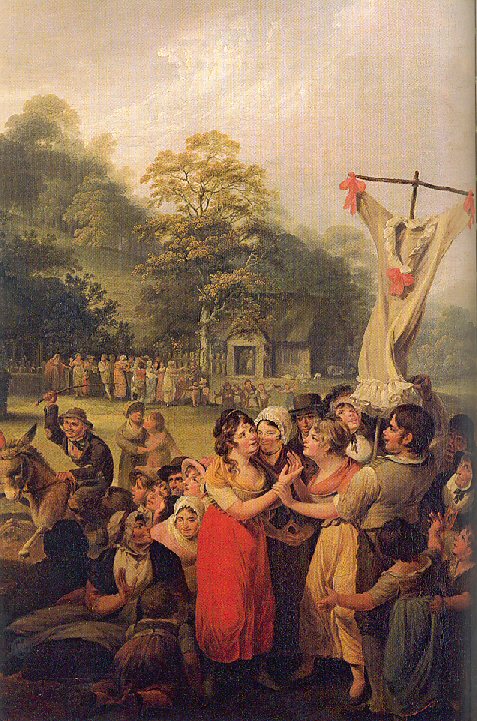 - This image here above is another Paul Sandby Sketch and not wishing to repeat ourseleves - is such an exciting image. It needs to be bigger really but for now this is the only size I have. If you have a close look at it, the lady standing up working at the tubs is wearing a stiff-enough-something at her body to create that angle at her bust and in a larger image you can see the stays sticking up at her back. You can just about make it out in this image if you look at the back of her shift. She is definitely wearing a pair of boned stays for them to be that stiff that they stick up out at the back. Her colleague also appears to be in a pair of high-backed stays with CB lacing and of a beige brown colour. And just check out the barrels balanced on chairs and the incredible detail involved in this painting.
- This image here above is another Paul Sandby Sketch and not wishing to repeat ourseleves - is such an exciting image. It needs to be bigger really but for now this is the only size I have. If you have a close look at it, the lady standing up working at the tubs is wearing a stiff-enough-something at her body to create that angle at her bust and in a larger image you can see the stays sticking up at her back. You can just about make it out in this image if you look at the back of her shift. She is definitely wearing a pair of boned stays for them to be that stiff that they stick up out at the back. Her colleague also appears to be in a pair of high-backed stays with CB lacing and of a beige brown colour. And just check out the barrels balanced on chairs and the incredible detail involved in this painting.- This following image is a small part of a larger painting by Joseph Parry and painting very late in the century around 1790's. The details that we are interested in here is obviously the stays that both ladies about to run in the 'Smock Race' are wearing. There are a few paintings that display this country fair style of sport and the 'Smock' to be won is what is hanging up behind them. They look a little like they are quarreling with the ref don't they. You can see everything here from the binding at the top of the thick stays to the stitching between each bone. This is a typical Plebeian sport and was done to win the luxurious smock that would have been far nicer than a homespun or rough linen cheap one they might have been wearing.
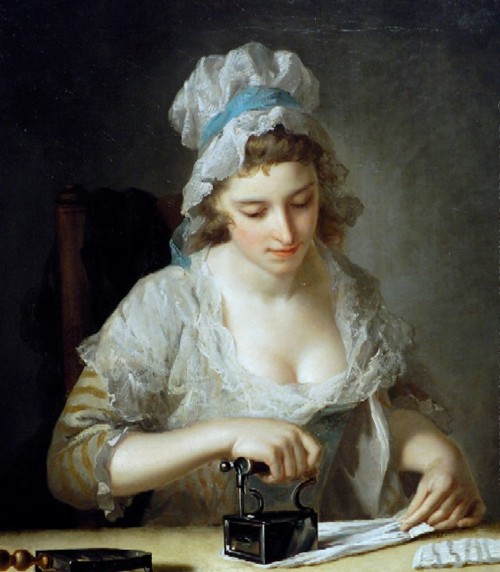 - The next image is a clothed one by Henry Morland and although we can't prove she is wearing stays her shape suggests so. We're also getting out of possible territory here with this image. Servants can be a tricky grey area as they have a reliable income, are open to possible hand-me-downs from their employers and who also may encourage them to dress smarter for the advertisement of the family's wealth. But, however, she is likely to be from Plebeian status and is working and is likely to be wearing a pair of stays so we are counting her in!
- The next image is a clothed one by Henry Morland and although we can't prove she is wearing stays her shape suggests so. We're also getting out of possible territory here with this image. Servants can be a tricky grey area as they have a reliable income, are open to possible hand-me-downs from their employers and who also may encourage them to dress smarter for the advertisement of the family's wealth. But, however, she is likely to be from Plebeian status and is working and is likely to be wearing a pair of stays so we are counting her in!- O.k, another image is part of Hogarth's 'Harlot's Progress' and it is the scene is where the heroin is getting out the carriage, having just arrived in London. Her country style clothing (in particular her hat according to some) marks her out as new to London and a Brothel Keeper already has her figured and is luring her in. Her silhouette suggests that she 's wearing a pair of stiff stays. She's also wearing a cap under her hat and a full robe, which was not the poorest way of dressing. She is also wearing a bosom flowers
Ok. So we're still adding images. Next is another painting by Francis Wheatley and is entitled 'The Benevolent Cottager'. Lady is in Undress and is clearly in stays, not only is the ribbon detail bisible taht was used to cover up the seams, but the boning channels are clearly visible. It is a browny-pink colour and she wears it with a plainly quilted petticoat.
Next we have a wonderful, wonderful image of what is possibly a servant getting washed - and there are her stays, balanced on the back of a chair right next to her - wow to the pinterest person who discovered this one!
I am currently working on this section on my website handboundcostumes.co.uk and then will copy it over once it's done. Please go to the website if you'd like to read the work in progress - click on the link above and go to the 'News' section, if not this section should be updated here in a couple of days - I hope! It's so much easy to write it once and then copy and paste, rather than keeping two separate blog simultaneously. Thanks!
Except it seems the pages for this on my website aren't currently working - please bear patiently with us while we try to sort this out. This article is being worked on and added to.
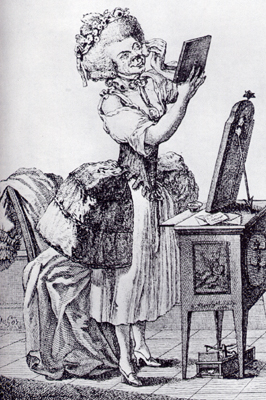
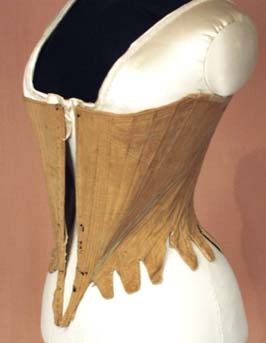
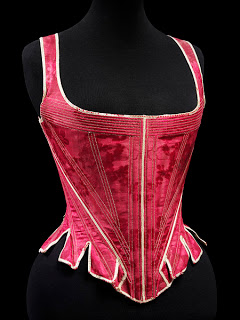

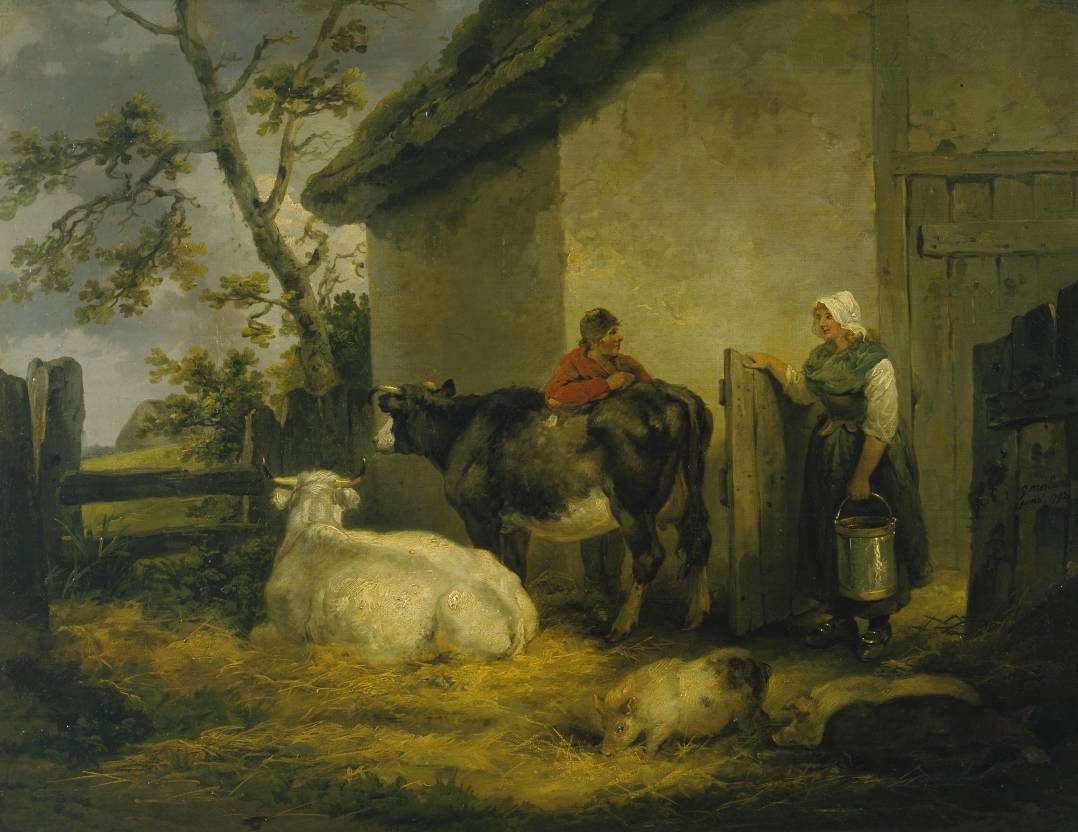



No comments:
Post a Comment